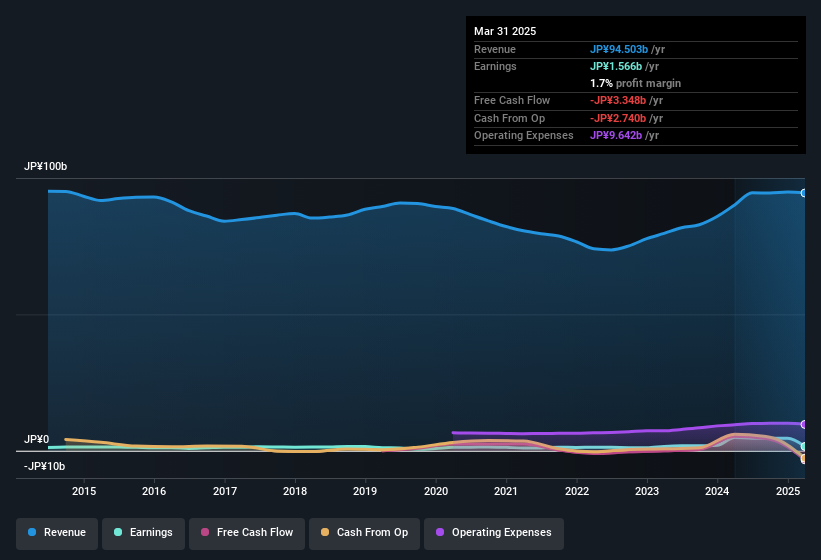- Japan
- /
- Trade Distributors
- /
- TSE:8007
Takashima's (TSE:8007) Shareholders Have More To Worry About Than Only Soft Earnings
The subdued market reaction suggests that Takashima & Co., Ltd.'s (TSE:8007) recent earnings didn't contain any surprises. We think that investors are worried about some weaknesses underlying the earnings.

Examining Cashflow Against Takashima's Earnings
Many investors haven't heard of the accrual ratio from cashflow, but it is actually a useful measure of how well a company's profit is backed up by free cash flow (FCF) during a given period. In plain english, this ratio subtracts FCF from net profit, and divides that number by the company's average operating assets over that period. This ratio tells us how much of a company's profit is not backed by free cashflow.
That means a negative accrual ratio is a good thing, because it shows that the company is bringing in more free cash flow than its profit would suggest. That is not intended to imply we should worry about a positive accrual ratio, but it's worth noting where the accrual ratio is rather high. Notably, there is some academic evidence that suggests that a high accrual ratio is a bad sign for near-term profits, generally speaking.
Takashima has an accrual ratio of 0.22 for the year to March 2025. We can therefore deduce that its free cash flow fell well short of covering its statutory profit. Even though it reported a profit of JP¥1.57b, a look at free cash flow indicates it actually burnt through JP¥3.3b in the last year. It's worth noting that Takashima generated positive FCF of JP¥5.3b a year ago, so at least they've done it in the past. However, that's not all there is to consider. The accrual ratio is reflecting the impact of unusual items on statutory profit, at least in part. The good news for shareholders is that Takashima's accrual ratio was much better last year, so this year's poor reading might simply be a case of a short term mismatch between profit and FCF. As a result, some shareholders may be looking for stronger cash conversion in the current year.
Check out our latest analysis for Takashima
Note: we always recommend investors check balance sheet strength. Click here to be taken to our balance sheet analysis of Takashima.
How Do Unusual Items Influence Profit?
The fact that the company had unusual items boosting profit by JP¥396m, in the last year, probably goes some way to explain why its accrual ratio was so weak. While we like to see profit increases, we tend to be a little more cautious when unusual items have made a big contribution. When we analysed the vast majority of listed companies worldwide, we found that significant unusual items are often not repeated. And that's as you'd expect, given these boosts are described as 'unusual'. If Takashima doesn't see that contribution repeat, then all else being equal we'd expect its profit to drop over the current year.
Our Take On Takashima's Profit Performance
Summing up, Takashima received a nice boost to profit from unusual items, but could not match its paper profit with free cash flow. For the reasons mentioned above, we think that a perfunctory glance at Takashima's statutory profits might make it look better than it really is on an underlying level. Keep in mind, when it comes to analysing a stock it's worth noting the risks involved. For example, Takashima has 3 warning signs (and 1 which shouldn't be ignored) we think you should know about.
Our examination of Takashima has focussed on certain factors that can make its earnings look better than they are. And, on that basis, we are somewhat skeptical. But there are plenty of other ways to inform your opinion of a company. For example, many people consider a high return on equity as an indication of favorable business economics, while others like to 'follow the money' and search out stocks that insiders are buying. While it might take a little research on your behalf, you may find this free collection of companies boasting high return on equity, or this list of stocks with significant insider holdings to be useful.
Valuation is complex, but we're here to simplify it.
Discover if Takashima might be undervalued or overvalued with our detailed analysis, featuring fair value estimates, potential risks, dividends, insider trades, and its financial condition.
Access Free AnalysisHave feedback on this article? Concerned about the content? Get in touch with us directly. Alternatively, email editorial-team (at) simplywallst.com.
This article by Simply Wall St is general in nature. We provide commentary based on historical data and analyst forecasts only using an unbiased methodology and our articles are not intended to be financial advice. It does not constitute a recommendation to buy or sell any stock, and does not take account of your objectives, or your financial situation. We aim to bring you long-term focused analysis driven by fundamental data. Note that our analysis may not factor in the latest price-sensitive company announcements or qualitative material. Simply Wall St has no position in any stocks mentioned.
About TSE:8007
Takashima
Engages in the design, proposal, process, material sale, and distribution of construction and building products in Japan.
Adequate balance sheet average dividend payer.
Market Insights
Community Narratives




